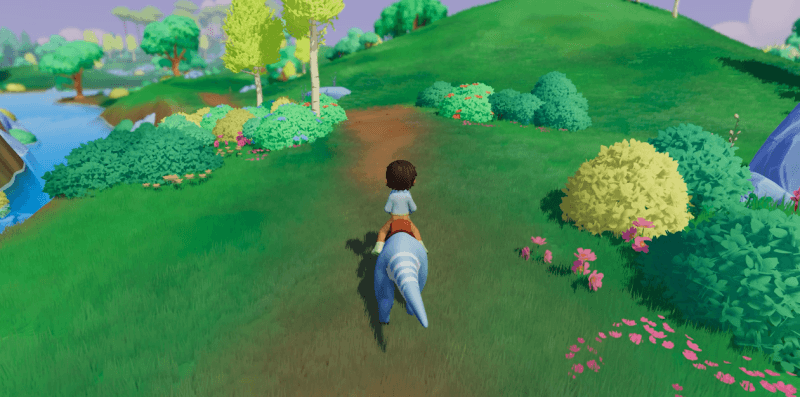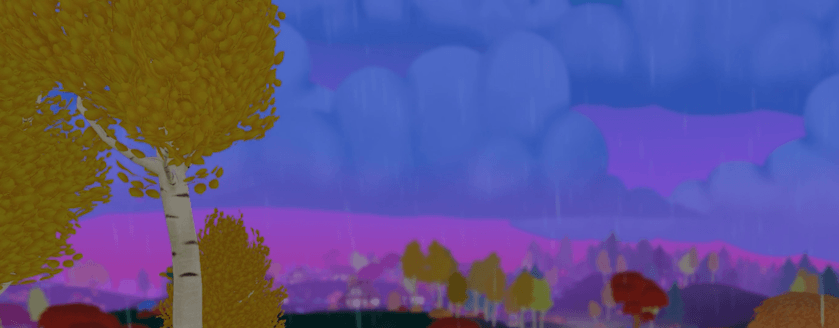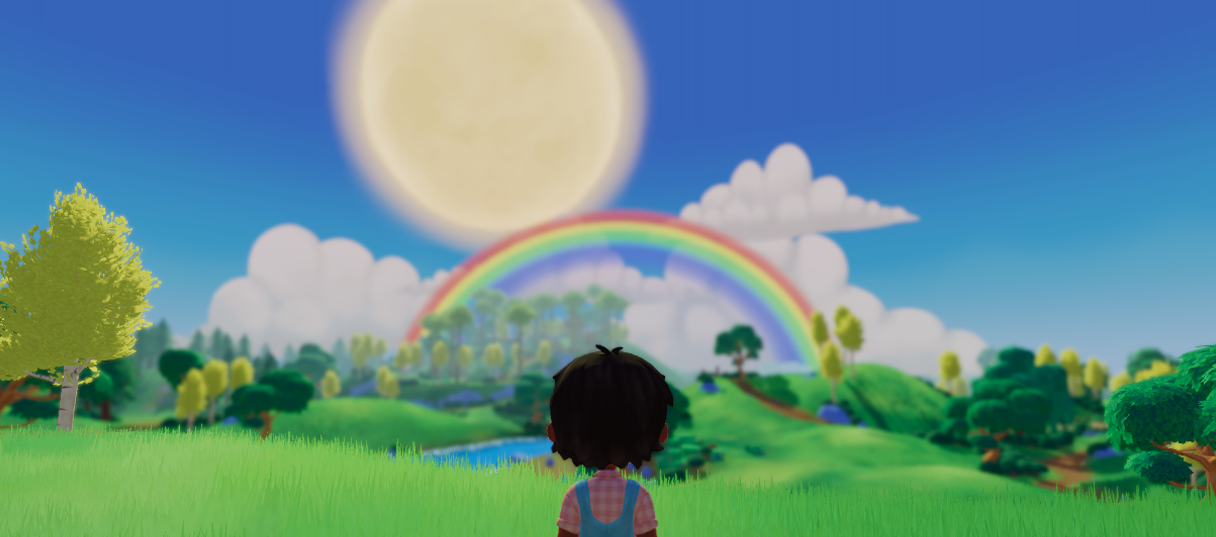Howdy Ranchers!
Howdy Ranchers! In this month’s Dino Diaries we have the pleasure of introducing you to the seasons and weather that you’ll experience within Paleo Pines. Seasons are often a big part of games that include farming, foraging and exploring and our game is no exception!
The Seasons of Paleo Pines
Paleo Pines is a very unique land, so it made sense during our worldbuilding sessions to ensure that the seasons we developed were just as unique and reflected the special feeling that we want everyone to experience throughout gameplay. We decided upon a world with three seasons: Triassea, Jurassos, and Cretumnus. Let’s take a look at each.

Triassea is a time of beautiful blossoms and rainbows, where pleasantly cloudy days are broken up by occasional light and refreshing rainfall. This is the season that you first experience in Paleo Pines. With Triassea comes your first experience with the different types of crops that have multiple uses in the world of Paleo Pines. Whilst most are available all year round, certain trees and bushes might only grow and drop fruit in certain times of the year!

Jurassos is a hotter, more tropical time of year. It is rarely cloudy, and even more rarely rainy. It is a time for tasty fruit, relaxing by the water and soaking up the sunshine. Whilst exploring the world you will find that the colours of the flora will adapt to the climate to really bring the places you visit life and a sense of an ever-changing environment.

Cretumnus is the blustery time of year, normally cloudy with the rain showing up a bit more frequently. It is a time of coloured leaves and sunsets. Taking your eyes away from the beautiful view atop the hills. You will notice the leaves begin to change from green to orange and red. Each season brings different experiences and exciting things to discover all year round.

We had a chat with our Game Director, Nina, about the three seasons in Paleo Pines.
How did you decide upon the three seasons?
It’s funny, but our starting point was actually no seasons at all! Paleo Pines was inspired by childhood summers. You know, when the days feel so long, the skies are blue, you’re out playing in the woods, imagining dinosaurs in the bushes. That kind of feeling. So why have seasons at all, right?
The thing is, seasons are wonderful ways to mark the passage of time and add variety. There’s something beautiful about cycles. And just like the summer, other seasons have wonderful childhood memories, splashing in spring puddles, throwing red leaves in the air, and so on. There is fun to be found in all kinds of weather! So how could we mix that with perpetual summer? We invented new seasons!
How did you decide on the names of the seasons?
As you can imagine, when we settled on three seasons, it was important that our seasons were not identical to the real world. So we had to come up with new names. A team member immediately suggested naming them after the Triassic, Jurassic, and Cretaceous periods. I wasn’t so sure, because they’re sequential rather than cyclical. I looked for inspiration high and low. For names of seasons in other languages and also ancient languages. And actually, the suggestion was a really great inspiration. We combined the periods with ancient words for seasons. Kevin (Narrative) and I tried out a bunch of different options, tried to combine them in a bunch of ways. Eventually, we settled on what it is now – Triassea, Jurassos, and Cretumnus.
Is there changing weather in each season?
Yes, there are different weathers for different seasons, although some weather can happen in any season – for example, gentle rain, or gentle sunshine. One of the greatest challenges with the weather has been to make the weathers feel different and distinct, but not to make them feel too dull and grey. After all, the feeling of perpetual summer is always in the back of our minds. But sometimes you can’t entirely avoid it. For example, we have included stormy weather. And it’s not even the tiniest bit sunny, haha! But it’s rare, and that makes it extra special.

Does weather affect gameplay and discovery?
Oh yes it does! Some of the effects are obvious. For example, you don’t have to water your crops on a rainy day. But weather also affects other things, like where you can find dinos. Some dinos prefer to be by the river on sunny days. Some rare coloured dinos only appear during certain weather conditions or seasons. And fruit from trees and bushes only grows in certain seasons – Cretumnus apples, Triassea pears. There’s more… but I don’t want to spoil it!
Seasonal Palettes
In Paleo Pines, as in our world, a change of seasons signals a change in foliage, weather and can define the player experience. We found out from artist Britt what it was like creating the colour palettes for our seasons and what were some of the challenges she faced.
What is a seasonal colour palette and why was it important to develop?
We really wanted each season in the game to feel visually distinct from one another so it was important that each one have its own unique colour palette. Each season’s colour palette consists of a set range of different colours which are used for the foliage, flowers and terrain in the level. For example, in Triassea all the flowers use pastel colours, the grass is a fresher green and the trees are softer in tone. On the other hand, in Jurassos the foliage and grass is much deeper with more yellows and the flowers are much brighter across the board. This helps create a consistent and fresh atmosphere in each season. A little change can have a big impact, so these colours need to be tested a few times in-game to get that feeling just right.

Overview for spring colours from one of Britt’s design documents.
What kinds of challenges did you have ensuring that the colour palettes would flow smoothly from one another as the seasons change?
I think the biggest challenge was making a level work just as harmoniously in all three seasons while still having no two seasons that were too similar. We didn’t want a new season to feel overloaded with new colours to the point where they no longer looked complementary the way they had previously.
We added a variation system on bushes and trees which means they can actually use three different foliage colours per season depending on where they are on the map. This allowed us to add more richness to the palettes and also the ability to mix in colours from older seasons for a nicer transition. In Cretumnus for example, having every bush turn orange felt like a huge shift and was a bit monotonous. With the variation system, we could have the same bush across the map vary between orange, red and occasionally green, which was easier on the eye and a nicer transition from the previous season – it also felt a lot more natural.

How does a well-defined colour palette set the mood in a game environment?
Colour has a big impact on mood in any form of media and games are no different. In Paleo Pines, we want players to feel a sense of peace, harmony and excitement which means our colour palettes should be reflecting this as much as possible to help the player to achieve these emotions while exploring our game.
Creating Weather
A change of seasons is all well and good but it’s only with a change in weather that it all comes to life. We spoke with VFX artist Hannah and programmer Rob about how they made the magic happen.
What types of weather will we encounter in the game?
Rob: The weather in Paleo Pines is ever-changing and makes the world feel alive and exciting because you never know what tomorrow is going to be like. One day might be sunny whilst you are planting seeds and watering them, but the next day you might get some rain and wind, saving you time to pet dinos and do other activities!
What difficulties did you encounter when creating the VFX for weather?
Hannah: one of the more difficult processes I encountered when creating the VFX was the blowing leaves effect for the windy seasons. We had to make sure that the wind speed of the leaves blowing off the trees matches the wind speed in the game for the different types of windy days. Another difficulty that we had with the VFX was the rain hitting off surfaces, Scott (rigging, shaders) did an amazing job at creating a shader to make it look like water running on surfaces.

Were there limitations with programming or VFX that made you decide to select one form of weather over another?
Rob: When programming the weather we had no particular limitations or issues. The VFX is the difficult part, and rain is one of the hardest to get right anyway. The more exotic weather like lightning or fog is actually easier than plain old rain.
In Paleo Pines, we wanted to make the weather as realistic as possible. Those times where it will rain for 3 days in a row before the sun finally comes out? We have those. This also means that on those days, you won’t have to water your plants to keep them healthy!
Throughout the seasons the weather will change in a way that it is unlikely that any season feels exactly the same. Certain weather types will happen at one time of the year whilst at another point in time, it will be replaced by something else.
Paleo Tip: Keep an eye out on stormy days for little surprises!

We’d love to hear what you’d like to see next in our Dev Blog. Jump into our Discord channel, or send us a note on our social channels below:
Twitter: http://www.twitter.com/PaleoPines
Instagram: http://www.instagram.com/Paleo_Pines
Facebook: http://www.facebook.com/PaleoPines
Discord: https://discord.com/invite/5mjbs6D
TikTok: @italicpig Psst. This is a new one for us so we’d love your support.